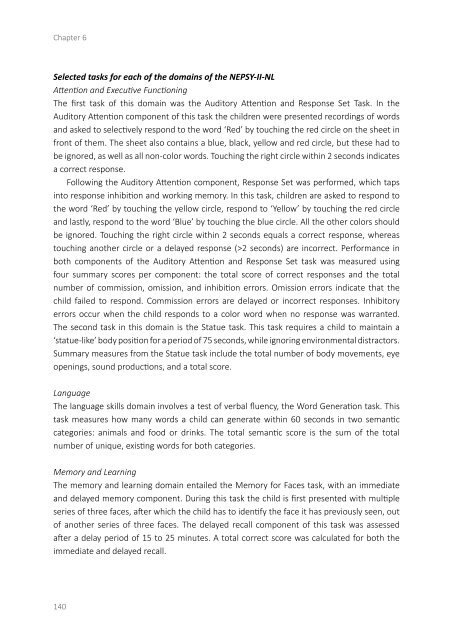On the Spectrum
2lm5UyR
2lm5UyR
You also want an ePaper? Increase the reach of your titles
YUMPU automatically turns print PDFs into web optimized ePapers that Google loves.
Chapter 6<br />
Selected tasks for each of <strong>the</strong> domains of <strong>the</strong> NEPSY-II-NL<br />
Attention and Executive Functioning<br />
The first task of this domain was <strong>the</strong> Auditory Attention and Response Set Task. In <strong>the</strong><br />
Auditory Attention component of this task <strong>the</strong> children were presented recordings of words<br />
and asked to selectively respond to <strong>the</strong> word ‘Red’ by touching <strong>the</strong> red circle on <strong>the</strong> sheet in<br />
front of <strong>the</strong>m. The sheet also contains a blue, black, yellow and red circle, but <strong>the</strong>se had to<br />
be ignored, as well as all non-color words. Touching <strong>the</strong> right circle within 2 seconds indicates<br />
a correct response.<br />
Following <strong>the</strong> Auditory Attention component, Response Set was performed, which taps<br />
into response inhibition and working memory. In this task, children are asked to respond to<br />
<strong>the</strong> word ‘Red’ by touching <strong>the</strong> yellow circle, respond to ‘Yellow’ by touching <strong>the</strong> red circle<br />
and lastly, respond to <strong>the</strong> word ‘Blue’ by touching <strong>the</strong> blue circle. All <strong>the</strong> o<strong>the</strong>r colors should<br />
be ignored. Touching <strong>the</strong> right circle within 2 seconds equals a correct response, whereas<br />
touching ano<strong>the</strong>r circle or a delayed response (>2 seconds) are incorrect. Performance in<br />
both components of <strong>the</strong> Auditory Attention and Response Set task was measured using<br />
four summary scores per component: <strong>the</strong> total score of correct responses and <strong>the</strong> total<br />
number of commission, omission, and inhibition errors. Omission errors indicate that <strong>the</strong><br />
child failed to respond. Commission errors are delayed or incorrect responses. Inhibitory<br />
errors occur when <strong>the</strong> child responds to a color word when no response was warranted.<br />
The second task in this domain is <strong>the</strong> Statue task. This task requires a child to maintain a<br />
‘statue-like’ body position for a period of 75 seconds, while ignoring environmental distractors.<br />
Summary measures from <strong>the</strong> Statue task include <strong>the</strong> total number of body movements, eye<br />
openings, sound productions, and a total score.<br />
Language<br />
The language skills domain involves a test of verbal fluency, <strong>the</strong> Word Generation task. This<br />
task measures how many words a child can generate within 60 seconds in two semantic<br />
categories: animals and food or drinks. The total semantic score is <strong>the</strong> sum of <strong>the</strong> total<br />
number of unique, existing words for both categories.<br />
Memory and Learning<br />
The memory and learning domain entailed <strong>the</strong> Memory for Faces task, with an immediate<br />
and delayed memory component. During this task <strong>the</strong> child is first presented with multiple<br />
series of three faces, after which <strong>the</strong> child has to identify <strong>the</strong> face it has previously seen, out<br />
of ano<strong>the</strong>r series of three faces. The delayed recall component of this task was assessed<br />
after a delay period of 15 to 25 minutes. A total correct score was calculated for both <strong>the</strong><br />
immediate and delayed recall.<br />
140


